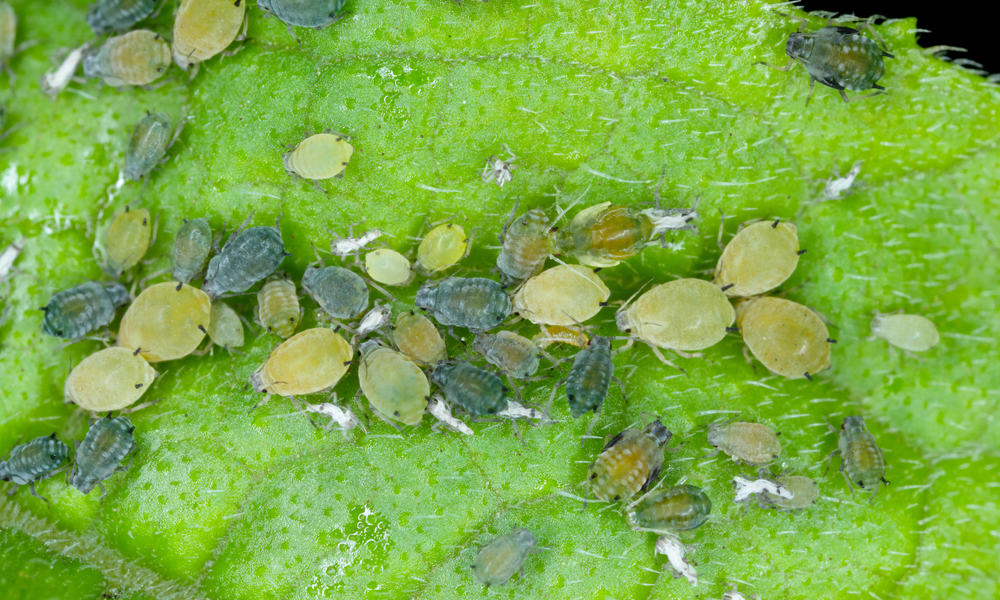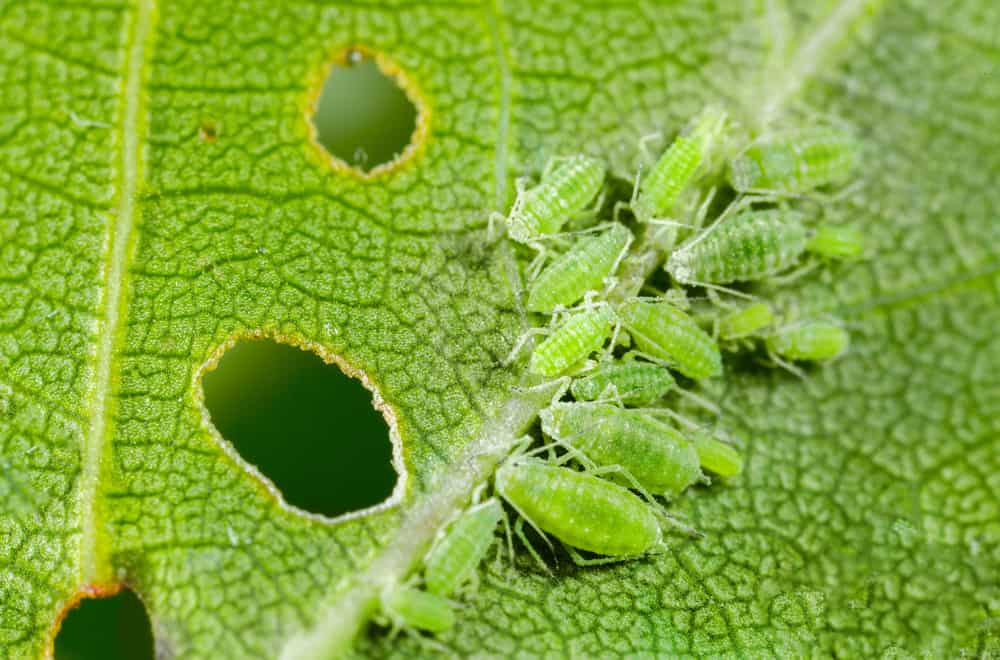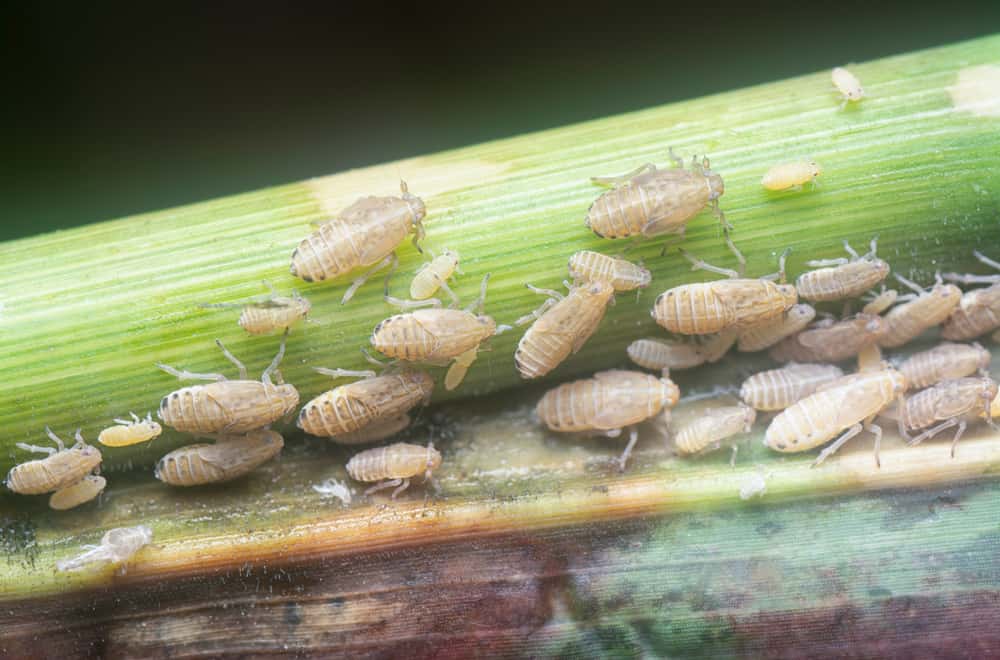Nobody likes pests in their garden. They are a nuisance and inflict a lot of damage. Aphids fall under this category. Have you ever encountered them in your garden or farm? Large infestations pose a significant threat to plant growth and life.
What do aphids eat? In this article, we’ll find the answer to this question and how to get rid of them.
What Do Aphids Eat?
Aphids are tiny soft-bodied insects that enjoy feeding on plant juices (sap), mainly in temperate regions. They are classified as one of the most destructive pests.
Aphids are herbivorous insects that suck plant juices out of plants’ stems, leaves, and roots. The juices aphids feed on often contain more sugar than protein. Therefore, they have to drink a lot of the sugary juices to attain enough protein. As a result, they excrete a lot of the sugar.
The excreted sugary liquid is known as “honeydew,” which serves as a food source for other insects like ants.
Some species solely feed on one plant, whereas others feed on different plant varieties. Aside from crops like corn, cabbage, and kale, they also threaten other plant species, such as ornamental plants.
Aphids species that feed on one type of plant are generally referred to as monophagous. Species like the green peach aphids feed on several plant species.
They feed on sap using their sucking mouthparts known as stylets. When their host plants’ quality becomes poor or excessively crowded, they produce winged offspring that migrate to other food sources.
Adult-winged aphids determine new host plants. If the plant looks and smells right, the next move will be to land on it and immediately begin feeding on it.
Aphids will penetrate the plant using their stylets and secrete saliva that softens the tissue to ease feeding. They dislike feeding alone and will often be found feeding in great numbers.
Other aphid species, such as the root aphid, feed primarily on the root exposing the infected part of the plant to mildew, root rot, and other diseases.
Harm Of Aphids
Aphids are well known as pests by most people, especially crop farmers, as they cause a lot of destruction in various ways.
Honeydew, the excess sugars excreted by aphids, serves as a food source for insects like ants. Ants will protect aphids from other predators like ladybugs so they can continue to indulge in the delicacy. Consequently, this codependence allows the aphids to cause maximum damage to the host plant.
Many aphids feeding on a host inflict damage by draining them of nutrients that will eventually cause them to wither.
When honeydew is not washed off from plants, it may build up to form sooty molds (a large group of fungi) that weaken the process of photosynthesis and encourage other fungal diseases to attack the plant.
The salivary secretions produced by some aphids are poisonous to plants (phytotoxic), which leads to stunted growth, gall formation ( swellings) on the surface of the plant or animal tissues) and leaf deformation.
One of the most severe problems posed by aphids is vectoring of plant viruses. Vectoring refers to organisms that carry disease-causing microorganisms from one host to another.
Aphids will transfer viruses after feeding on an infected plant and migrating to another. Heavy infestations of aphids weaken and will ultimately lead to the plant’s death.
When aphids feed on plants excessively, it causes the flowers or fruit of a plant to become distorted.
Tips To Get Rid Of Aphids
Nobody wants to have these little pests in their farm, yard, or garden. The destruction aphids cause to plants may be severe and difficult to bounce back from.
However, there are preventive measures you could take to tackle the infestation. In addition, the sooner you discover them, the easier it will be to get rid of them. The following are some steps you could take to reduce aphid infestation:
- You can use nets to shield your crops from aphids. Nets, such as mosquito nets, serve as a barrier between the pest and your plant.
- Getting rid of crop residues like leaves may help discourage them from invading your crops.
- Remove weeds in your garden or farm that may serve as a suitable hiding place for aphid eggs and adults.
- Alternatively, you can also get rid of aphids by use of your hands. First, you could spray the aphids with a steady stream of water using a garden hose.
Secondly, you could put on gardening gloves and knock them off the stems, leaves, buds, or plant flowers straight into a bucket of soapy water to kill them.
Lastly, you could prune or cut out the affected part of the plant and drop them into a bucket of soapy water.
- You can make use of natural and organic sprays. One way is by mixing liquid soap and water in a bucket and applying the solution to the affected plant areas using a spray bottle.
The soap dissolves the protective layer of the aphid’s body and eventually kills them. You could buy insecticidal soaps online or at your local nursery.
- Neem oil acts as a natural repellant for a lot of insects, aphids included. You should mix with water per the instructions of the product. Follow this by adding the mixture to a spray bottle and spray the affected area.
- You can also use essential oils to get rid of aphids. In a spray bottle, mix about 4-5 droves of clove, rosemary, peppermint, and thyme with water. Afterward, spray the affected areas of the plant, primarily targeting mature aphids, their larvae, and eggs.
- Introduce natural predators to your garden. Aphids have numerous predators, such as ladybugs, green lacewings, the parasitoid wasp, and minute pirate bugs.
- Adult ladybugs don’t eat as many aphids as those in their larvae stage (offspring). The higher the aphid population, the more the ladybugs will feed enough to mate and lay eggs. You can buy live ladybugs online.
- Green lacewings also do the trick—their larvae aid in controlling the aphid population on plants. You can also buy them via online stores.
- Build or purchase birdhouses for bug-feeding birds like chickadees and wrens to live in, and they’ll return the favor. By feeding on aphids and other insects, they’ll help control aphids pests’ populations.
- Grow the plants that will help repel aphids or attract beneficial insects (aphid predators). Alternatively, you can grow plants that aphids like (trap plants) to lure them away from the plants you want to protect.
- Some plants that attract beneficial insects include mint, dill, yarrow, clover, and fennel.
- Aphid repellant plants include allium, onion, chives, catnip, and garlic.
- Some examples of trap plants include cosmos, dahlias, nasturtium, asters, zinnias, and mustard.
- You can utilize Diatomaceous earth (DE) to kill aphids. DE is an organic, non-toxic material that will kill aphids when applied to the affected parts of the plant.
- Purchase pyrethrum sprays which are highly effective against aphid infestations. Before the pest becomes a big problem, inspect and spray the affected parts of the plant.
- You can make use of yellow water traps and yellow sticky traps to monitor winged aphids. The color yellow is known to attract insects, including beneficial insects. That said, use sticky traps when necessary.
- Make your own sticky board traps. You can do this by spreading used motor oil or petroleum on yellow plywood. The yellow color attracts the aphids to the board, where they’ll be trapped.
- Practice crop rotation. This is the growing of different crops in succession on the same field. This practice reduces aphid attacks, especially by those that feed on specific hosts.
- Ash is effective in the control of aphid infestation in vegetables. It would help if you evenly dusted it on the affected parts of the veggie plant.
The above steps are some of the most basic methods of aphid prevention and control. Putting them to practice will help you curb the growth and spread of these pests. In worst-case scenarios, you should seek professional assistance.
Frequently Asked Questions (FAQ)
What’s the average lifespan of an aphid?
Aphids live for about a month. They become sexually mature in ten days and lay eggs very often. They will produce several offspring throughout their lives.
Can aphids jump?
No. aphids do not jump. These tiny insects only crawl. If not immediately dealt with, they may rapidly breed and give rise to offspring that can fly.
Do aphids hibernate?
Aphids that inhabit temperate areas can survive overwinter without having to hibernate. Depending on the species, they can make it through winter.
How far do aphids travel?
Aphids may make long trips when looking for streams. They may cover distances of up to 30 kilometers. They do this mainly when searching for new suitable hosts to live and feed off.
Summary
Knowing “what do aphids eat” will enable you to take the necessary precautions to keep them from your garden or farm. Remember to swiftly act on them as soon as you see signs of their presence to contain their spread.
In cases of severe infestations, don’t feel shy about calling in the professionals.


